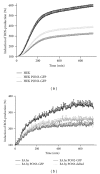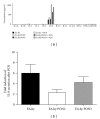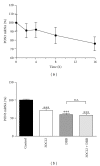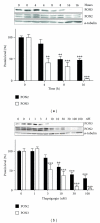Paraoxonases-2 and -3 Are Important Defense Enzymes against Pseudomonas aeruginosa Virulence Factors due to Their Anti-Oxidative and Anti-Inflammatory Properties
- PMID: 22570791
- PMCID: PMC3335252
- DOI: 10.1155/2012/352857
Paraoxonases-2 and -3 Are Important Defense Enzymes against Pseudomonas aeruginosa Virulence Factors due to Their Anti-Oxidative and Anti-Inflammatory Properties
Abstract
The pathogen Pseudomonas aeruginosa causes serious damage in immunocompromised patients by secretion of various virulence factors, among them the quorum sensing N-(3-oxododecanoyl)-L-homoserine lactone (3OC12) and the redox-active pyocyanin (PCN). Paraoxonase-2 (PON2) may protect against P. aeruginosa infections, as it efficiently inactivates 3OC12 and diminishes PCN-induced oxidative stress. This defense could be circumvented because 3OC12 mediates intracellular Ca(2+)-rise in host cells, which causes rapid inactivation and degradation of PON2. Importantly, we recently found that the PON2 paralogue PON3 prevents mitochondrial radical formation. Here we investigated its role as additional potential defense mechanism against P. aeruginosa infections. Our studies demonstrate that PON3 diminished PCN-induced oxidative stress. Moreover, it showed clear anti-inflammatory potential by protecting against NF-κB activation and IL-8 release. The latter similarly applied to PON2. Furthermore, we observed a Ca(2+)-mediated inactivation and degradation of PON3, again in accordance with previous findings for PON2. Our results suggest that the anti-oxidative and anti-inflammatory functions of PON2 and PON3 are an important part of our innate defense system against P. aeruginosa infections. Furthermore, we conclude that P. aeruginosa circumvents PON3 protection by the same pathway as for PON2. This may help identifying underlying mechanisms in order to sustain the protection afforded by these enzymes.
Figures






Similar articles
-
Human Paraoxonase-2 (PON2): Protein Functions and Modulation.Antioxidants (Basel). 2021 Feb 7;10(2):256. doi: 10.3390/antiox10020256. Antioxidants (Basel). 2021. PMID: 33562328 Free PMC article. Review.
-
Paraoxonase 2 is down-regulated by the Pseudomonas aeruginosa quorumsensing signal N-(3-oxododecanoyl)-L-homoserine lactone and attenuates oxidative stress induced by pyocyanin.Biochem J. 2010 Jan 27;426(1):73-83. doi: 10.1042/BJ20091414. Biochem J. 2010. PMID: 19925453
-
Dominant role of paraoxonases in inactivation of the Pseudomonas aeruginosa quorum-sensing signal N-(3-oxododecanoyl)-L-homoserine lactone.Infect Immun. 2008 Jun;76(6):2512-9. doi: 10.1128/IAI.01606-07. Epub 2008 Mar 17. Infect Immun. 2008. PMID: 18347034 Free PMC article.
-
Paraoxonase-2 deficiency enhances Pseudomonas aeruginosa quorum sensing in murine tracheal epithelia.Am J Physiol Lung Cell Mol Physiol. 2007 Apr;292(4):L852-60. doi: 10.1152/ajplung.00370.2006. Epub 2006 Nov 22. Am J Physiol Lung Cell Mol Physiol. 2007. PMID: 17122353
-
Inflammation, infection, cancer and all that…the role of paraoxonases.Adv Exp Med Biol. 2014;824:33-41. doi: 10.1007/978-3-319-07320-0_5. Adv Exp Med Biol. 2014. PMID: 25038992 Free PMC article. Review.
Cited by
-
Paraoxonase-2 (PON2) in brain and its potential role in neuroprotection.Neurotoxicology. 2014 Jul;43:3-9. doi: 10.1016/j.neuro.2013.08.011. Epub 2013 Sep 4. Neurotoxicology. 2014. PMID: 24012887 Free PMC article. Review.
-
A chronic pro-inflammatory environment contributes to the physiopathology of actinic lentigines.Sci Rep. 2024 Mar 4;14(1):5256. doi: 10.1038/s41598-024-53990-5. Sci Rep. 2024. PMID: 38438410 Free PMC article.
-
Sex and genetic differences in the effects of acute diesel exhaust exposure on inflammation and oxidative stress in mouse brain.Toxicology. 2016 Dec 30;374:1-9. doi: 10.1016/j.tox.2016.11.010. Epub 2016 Nov 16. Toxicology. 2016. PMID: 27865893 Free PMC article.
-
Human Paraoxonase-2 (PON2): Protein Functions and Modulation.Antioxidants (Basel). 2021 Feb 7;10(2):256. doi: 10.3390/antiox10020256. Antioxidants (Basel). 2021. PMID: 33562328 Free PMC article. Review.
-
Enhanced Clearance of Pseudomonas aeruginosa by Peroxisome Proliferator-Activated Receptor Gamma.Infect Immun. 2016 Jun 23;84(7):1975-1985. doi: 10.1128/IAI.00164-16. Print 2016 Jul. Infect Immun. 2016. PMID: 27091928 Free PMC article.
References
-
- Driscoll JA, Brody SL, Kollef MH. The epidemiology, pathogenesis and treatment of Pseudomonas aeruginosa infections. Drugs. 2007;67(3):351–368. - PubMed
-
- Boontham P, Robins A, Chandran P, et al. Significant immunomodulatory effects of Pseudomonas aeruginosa quorum-sensing signal molecules: possible link in human sepsis. Clinical Science. 2008;115(11):343–351. - PubMed
-
- Smith RS, Fedyk ER, Springer TA, Mukaida N, Iglewski BH, Phipps RP. IL-8 production in human lung fibroblasts and epithelial cells activated by the Pseudomonas autoinducer N-3-oxododecanoyl homoserine lactone is transcriptionally regulated by NF-κB and activator protein-2. Journal of Immunology. 2001;167(1):366–374. - PubMed
-
- Li H, Wang L, Ye L, et al. Influence of Pseudomonas aeruginosa quorum sensing signal molecule N-(3-oxododecanoyl) homoserine lactone on mast cells. Medical Microbiology and Immunology. 2009;198(2):113–121. - PubMed
-
- Jacobi CA, Schiffner F, Henkel M, et al. Effects of bacterial N-acyl homoserine lactones on human Jurkat T lymphocytes-OdDHL induces apoptosis via the mitochondrial pathway. International Journal of Medical Microbiology. 2009;299(7):509–519. - PubMed
LinkOut - more resources
Full Text Sources
Miscellaneous

